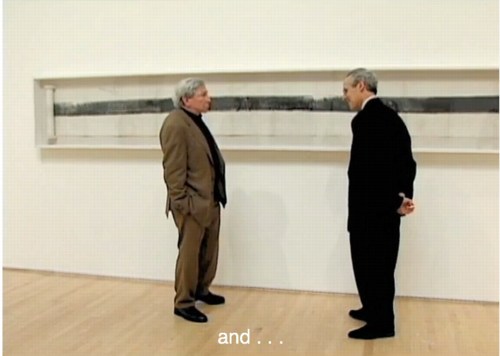
In the Fall of 1953, Robert Rauschenberg and John Cage, fast friends and mutual admirers from Black Mountain, collaborated on an artwork. Cage had already been studying with DT Suzuki and had been discussing Zen in great depth with Rauschenberg. Which dialogue had led, the summer before at Black Mountain, Rauschenberg to make his White Paintings, and to Cage and others to orchestrate Theater Piece No. 1 and to compose 4’33”. Rauschenberg had already stayed at Cage’s loft while his new Fulton St. studio was being fumigated, where he’d surprised Cage by painting the painting Cage got from Rauschenberg’s 1951 show at Betty Parsons completely black.
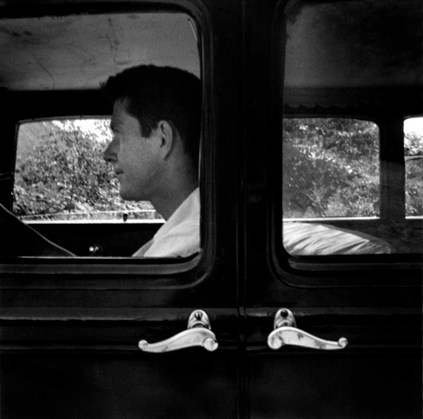
Untitled (John Cage, Black Mountain), 1952, photo: Robert Rauschenberg
For the work that came to be known as Automobile Tire Print, Rauschenberg pasted 20 sheets of drawing paper into a scroll, which he laid down on an empty Fulton St one Sunday, and he inked the rear tire while Cage drove his Model A in a straight line along the paper. [Cage drove the Model A to Black Mountain, above. Apparently, Kaprow had a Model A, too.]
Michael Kimmelman is fond of noticing the similarity between the long, lone mark made by moving through space and Barnett Newman’s “zips,” which Rauschenberg would have seen at Parsons’ gallery in 1951 and 1952.
In the catalogue for his 1991 show Rauschenberg in the 50s,, Walter Hopps links Automobile Tire Print in time, medium, and concept to another major collaborative work on paper, Erased de Kooning Drawing. It turns out that for the first decade-plus after their creation, neither work was exhibited publicly, and both were known largely by word of mouth. They were discussed without being seen; as the product–or to use Harold Rosenberg’s influential 1952 term, the “residue”–of process, their physical state was secondary. Which let Hopps and others interpret and present them as precursors of Conceptual Art once such a thing came into existence.
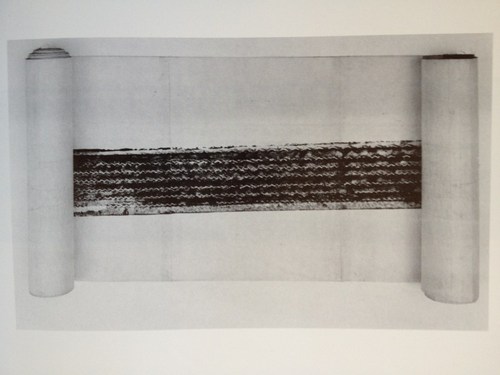
Hopps says that Automobile Tire Print was “maintained as a scroll” which was eventually mounted on fabric for preservation. Since it was first exhibited in the 70s [and yes, I guess I’ll have to start digging into this history now, too], the work has been unfurled to various lengths. [Above, from Hopps’ 1976 show at the Smithsonian] Since Hopps, and definitely since SFMOMA’s acquisition of the piece in 1998, it has been completely unfurled.
The accounts, even the descriptions of the work, vary. Hopps said it’s ink. Rauschenberg said it was “house paint,” like the black paint he was using at the time on his Black Paintings. And that he poured it out on the street in front of Cage’s tire.
In that SFMOMA video, Bob told David Ross that he asked his friend to help execute his idea. Cage “was the printer,” Ross suggested, “the printer and the press,” said the artist. Without entirely contradicting that view, Cage wrote in 1961 in Silence, “I know he put the paint on the tires. And he unrolled the paper on the city street. But which one of us drove the car?”
Perhaps ambiguous authorship is just one more way Automobile Tire Print is like Erased deKooning Drawing, a work in which the central, conceptually transformational contribution of Jasper Johns had been willfully omitted for more than four decades.
Not that these questions of credit and origin give BMW any cover at all on their mindblowing direct marketing campaign “marking the momentous occasion” of the 40th anniversary of the M Motorsports car series.
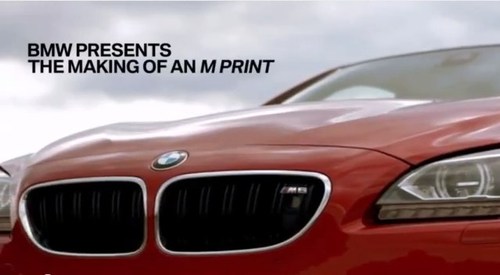
The company that regularly puts artists in the promotional driver’s seat on its Art Car series completely fails to mention either Rauschenberg or Cage in the video for the M Print project, which is essentially a cover version, or a re-performance, of Automobile Tire Print starring the M6 sports coupe. The resulting prints were then cut into postcard size, and sent to new and prospective owners.
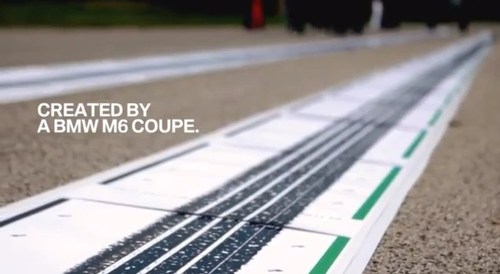
[FWIW, BMW also blanked a living artist, using the donut-spinning M6 (below) to re-enact Greeting Card, Aaron Young’s 2007 Park Avenue Armory motorcycle tire painting project. I’m sure if there were another car-related performance art project ransackable enough, BMW’s agency would have turned that one into postcards, too.]
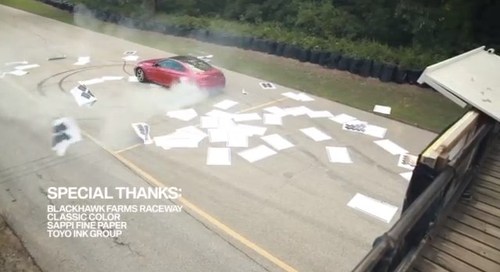
I guess it’s possible to look at this as a glass half full situation, that the indexical Zen performative aesthetic of Cage & Rauschenberg has, sixty years later, gone mainstream. Or at least turned into a PR stunt to sell $100,000 sports cars.
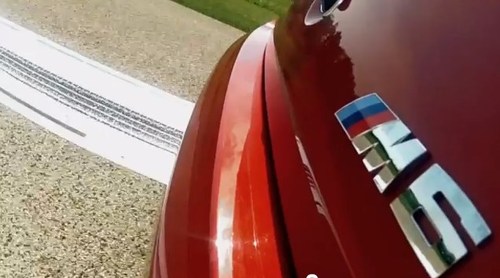
The only way this ends well is if it spawns a cars-meets-Fluxus fauxreality TV show on the History Channel. John and Bob would surely be delighted.
The BMW M6 Creates Its Own Direct Mail [fastcocreate.com]
BMW M Presents: The Making of an M Print [youtube]
Previously, unexpectedly related: greg.org coverage of John Cage’s VW bus and of
the unexamined making of Erased de Kooning Drawing
Skip to content
the making of, by greg allen
